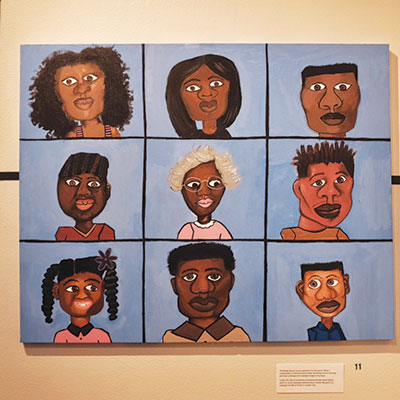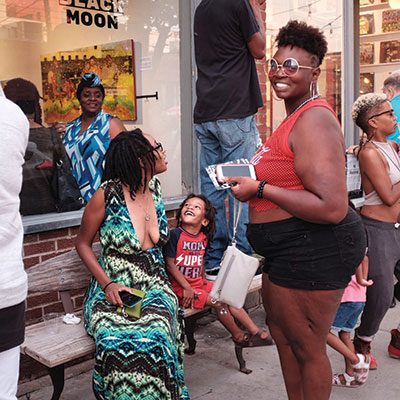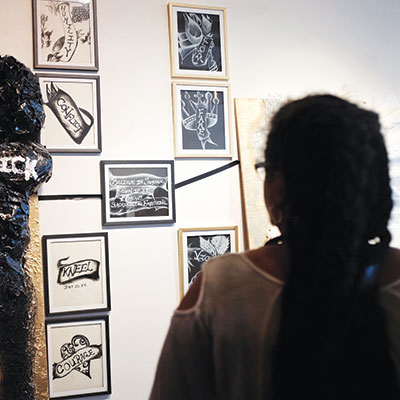My Black Life
New Black Moon show explores the complicated concept of blackness
SCENES FROM MY BLACK LIFE AT TULSA ARTISTS’ COALITION GALLERY
Makaila Mcgonigal
“I am invisible, understand, simply because people refuse to see me … it is as though I have been surrounded by mirrors of hard, distorting glass. When they approach me they see only my surroundings, themselves or figments of their imagination, indeed, everything and anything except me.”
–Ralph Ellison, Invisible Man
The first definition of the word black in the dictionary is “of the very darkest color owing to the absence of or complete absorption of light; the opposite of white.” Synonyms for the color include words like dark, pitch black, jet black, inky, coal-black, blackish, sable, Stygian.
Somewhere, between references to Dante’s Inferno and the color of the infinite void, black people actually exist. When it comes to a personal sense of my own blackness growing up as an “articulate” kid in Jackson, Mississippi, no metaphor has ever felt more honest than the one used by Oklahoma’s own Ralph Ellison: invisibility.
Blackness often feels like a kind of force field simultaneously obscuring me from the world while projecting identities and assumptions onto my life. Do I talk white? Am I real enough, hip-hop enough, appropriately woke? These are questions and concerns that always seemed tied to my life whether I liked it or not. Whether they fit me or not.
For the first time in my life, this unhealthy cultural dynamic seems to be changing. Beauty and the fact of our blackness have begun to share a bigger space in America. Black is sexy. Black is limitless, vulnerable and strong. Black people are reclaiming the power of their blackness and defining it for themselves.
* * *
On July 5, Black Moon, a collective of local black artists, debuted a new exhibition of works at the Tulsa Artists’ Coalition (TAC) Gallery downtown. My Black Life is dedicated to exploring the complicated concept of blackness through art and the personal stories of the artists.
Just a year into the group’s formation, Black Moon has been the subject of a national news story at NBC and been featured by numerous galleries and art spaces in Oklahoma. This collective has changed Black Moon founder Elizabeth Henley’s life in ways she could never have imagined.
“There are times when it’s really hard to balance a full-time job, being an artist, and orchestrating calls, meetings, and events,” Henley said. “I’ve been stretched in positions I’ve never thought I would have step into, like public speaking, business negotiations, and defending our artists and their work.”
For Henley, one of the most transformative aspects of the group’s rise over the past year has been belonging to a supportive community of artists with a shared vision. “We motivate, support, encourage and validate one another,” Henley said. “I know that I wouldn’t have grown as an artist, an individual, or as a member of this community if I wasn’t around these amazing creatives who make up Black Moon.”
My Black Life showcases a diverse collection of genres. The works include textured mixed media, photography, detailed fabric work, and paintings both abstract and figurative with an emphasis on expressive color and imagery. The show is structured like a timeline, organized around statements of each artist’s life experiences.
Each piece of art is supplemented by sentiments that reflect personal experiences involving blackness. I was told I talk like a white person and Someone asked to touch my hair appear next to the art where negative space might ordinarily exist.
Each artist’s sense of blackness is unique and deeply personal. Aundria Braggs, a Sailor Moon enthusiast and one of the collective members featured at the show, described growing up with a genuine disconnect between her personal feelings of blackness and her art.
“For a time the color of my skin had little to do with the work I created,” Braggs said. “While attending college I realized if I wanted my work to make an impact, it had to be personal. Many successful artist chose this path, and it is clear to see why. If I do not draw from my personal experience, what story can I tell? My blackness has much to do with how the world sees me, and I want to reflect the world back on itself.”
For some members, like the photographer Nosamyrag, the questions and culture associated with blackness have always provided an anchor for his work. As a kid the sketches he drew of the mundane parts of his world—his Nike shoes with peach colored laces, his neighborhood, his favorite cartoon characters—were the foundation of his art. Later, he started to document his life in real time with a disposable camera.
“It’s hard being black as-is and sometimes, certain things is all that you have. Photography is all that I have,” Nosamyrag said. “It gives me avenues to other things to where my thoughts and ideas are put for the public to see. It’s wild that people gravitate to it. It motivates me to take it to another level any way possible.”
The painter MOLLYWATTA reflects on the odd way media has fractured black cultural memory. Many black people who grew up in the ’80s and ’90s formed emotional attachments to television shows and movies in which people who look like them rarely appear. Her painting, A Shady-Bunch Spoof plays with this contradiction.
“The Brady Bunch opening grid [is] a strange and nostalgic image in my head,” MOLLYWATTA said. “I enjoy the idea of positively promoting blended black family, which is rarely embraced in media. My goal is to highlight the black family in modern-day.”
Some artists also expressed the question of blackness as though their blackness were a trap. It can be an emotional space that feels like quicksand where any decision makes things worse. The artist Christina Henley powerfully expresses this sentiment in her artist statement:
I remember at a previous job, a White coworker commenting on my hair, and then reaching their hand towards my head. Grabbing my hair. Fingers on my scalp and pulling my curls. Then wiped their hand on their pants and said, ‘I’ve always wanted to know how that feels.’ This was done in front of my other coworkers. They were quiet and wouldn’t look at me directly, but their faces looked worried. I just stood there and nervously laughed it off. I felt ashamed about my reaction. It was humiliating.
Christina Henley continues: “I’ve tried to be the safe black girl and woman. Non-threatening. Trying to assimilate. Too black for some. Too white for others. How am I supposed to be comfortably myself, if I’m constantly ostracized racially? I can’t change that. I don’t want to. So be it if I fit into some stereotypes and not others.”
Several artists emphasized the aesthetic beauty of blackness and black power in both their pieces and artist statements. Summer Washington’s pieces The Queen - Reluctant Warrior and Love in Chocolate - Snow Black both upend traditional white-centric notions of beauty.
“My objective is to showcase the beauty of the African woman within a contextual imagery typically depicted as Caucasian,” Washington said. “We are Lucy, AL 288-1, our Ethiopian ancestor, the first human, the origin of this world.” Washington was inspired by the writing of the Malawian poet Upile Chisala who wrote, “I am dripping melanin and honey. I am black without apology.”
Artist Erica Martez’s work also celebrates the beauty and power of black women. Her piece, The Most Disrespected Person in America is the Black Woman, referencing a speech by Malcom X, gets to the heart of her project. Martez believes that her creative gift has given her a platform to express and bring attention to the struggles of black people both past and present.
“Black women experience many intersections of oppression including racism, sexism, colorism and many more,” Martez said. “The plight of a black woman, it’s difficult. We are told to be strong without ever given the opportunity to show our weaknesses. If we do, we are told that we are angry, loud and bitter! We are held to unrealistic standards of beauty. When we need help, we are told we are lazy and weak—so, we carry burdens that were never meant for us. I decided to highlight the definition of beauty for black women; in spite of the stereotypes we face daily. We are beautiful without qualifications or explanation. We are magic.”
Alexander Tamahn is another Black Moon artist who views his work through an anthropological lens. “Art, for me, has been the convergence of creative expression and anthropology,” he said. “I have found employing mixed media best helps me consolidate the litany of things I could say about both my subjects and audience alike. My compositions are an amalgam of the sum of my developmental experiences, my spirituality, and my evolving perspective of the society and cultures to which I belong.”
While Tamahn’s work is focused and intellectual, the emotion is profoundly visceral. Tamahn’s canvases are teeming with dense, implacable color. His painting Black Peopling features a group sitting in repose, their surroundings soaked in layers of shimmering color: gold and red and green that appear transfigured like flame. Even the charcoal black wall behind them shimmers with texture and tiny pinholes of sparkling light.
Tamahn describes this paradoxical but lovely depiction of blackness in spiritual terms: “It is a unique privilege; an infinite ache; a resounding joy to see the world through these eyes.”
Black Moon has given new voice to an entire group of Tulsa artists. This type of community and creative freedom is one of the few sources of escape I’ve found from the sense of invisibility that often seems attached to blackness. On the group’s first anniversary, they seem collectively poised for new artistic milestones. The last year has been a wild ride, but these artists are just beginning to build their power together.
.jpg)





.jpg)
.jpg)
